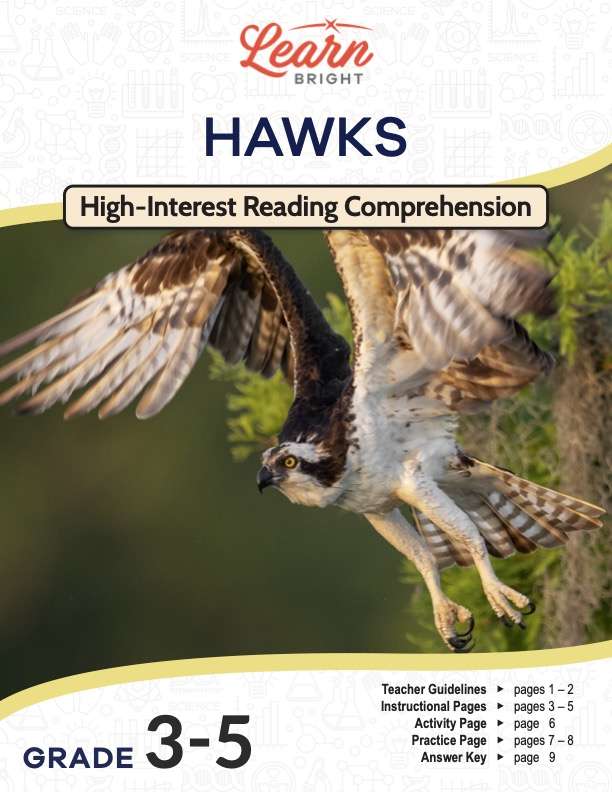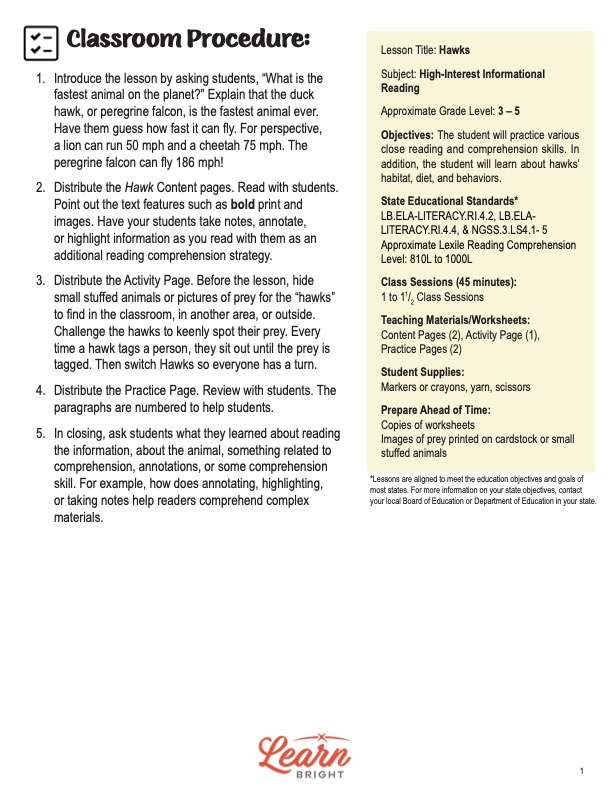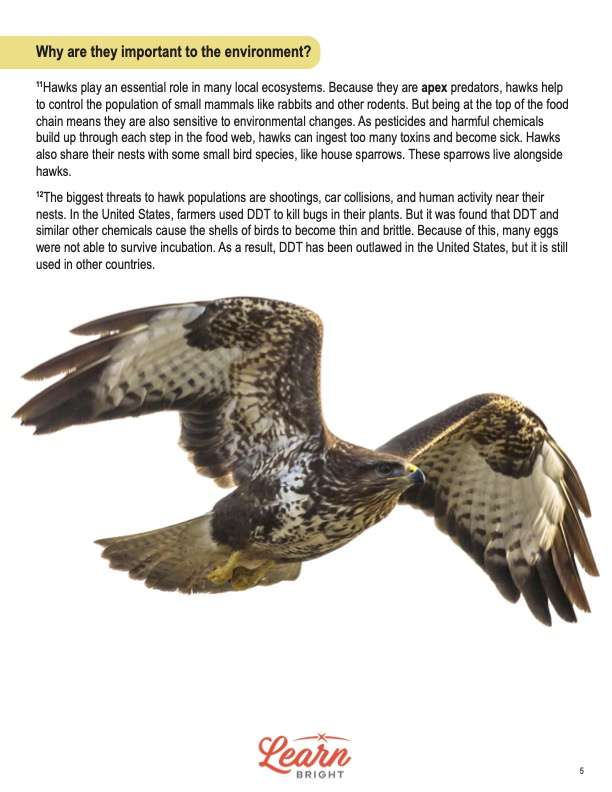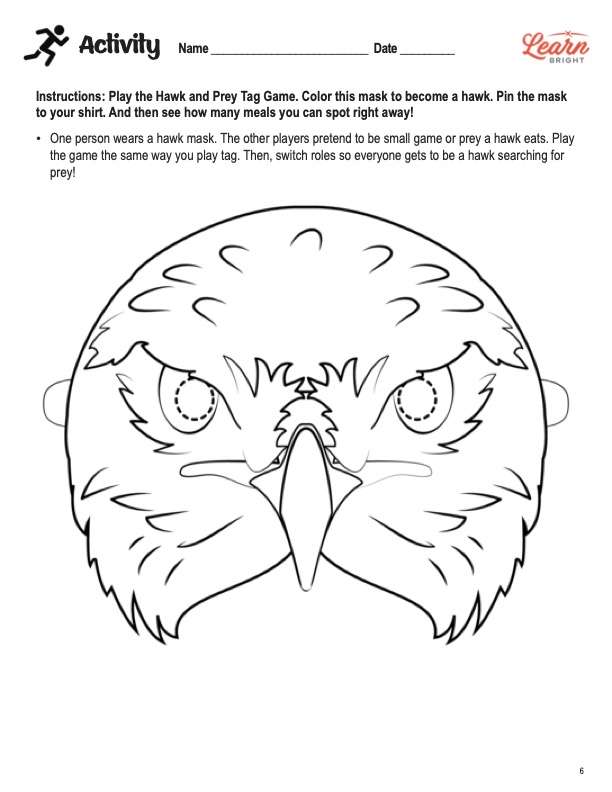Description
What our Hawks lesson plan includes
Lesson Objectives and Overview: Hawks is a high-interest reading comprehension lesson plan. As such, students will practice various close reading and comprehension skills. In addition, they will learn about hawks’ habitat, diet, and behaviors. This lesson is for students in 3rd grade, 4th grade, and 5th grade.
Classroom Procedure
Every lesson plan provides you with a classroom procedure page that outlines a step-by-step guide to follow. You do not have to follow the guide exactly. The guide helps you organize the lesson and details when to hand out worksheets. It also lists information in the yellow box that you might find useful. You will find the lesson objectives, state standards, and number of class sessions the lesson should take to complete in this area. In addition, it describes the supplies you will need as well as what and how you need to prepare beforehand. This lesson requires markers or crayons, yarn, and scissors.
Teacher Notes
The paragraph on this page provides a little more information or guidance on what to expect from the lesson. It explains that you can teach this lesson in a whole-class setting or to an independent, small group as an activity. You can use the blank lines to record any thoughts or ideas you have as you prepare.
HAWKS LESSON PLAN CONTENT PAGES
What Are Hawks?
The Hawks lesson plan contains three content pages. It begins by providing a box of background information about this animal. Hawks are part of the aves class (meaning birds) and live mainly in forests all around the world, except in Antarctica. They can live between 13 and 15 years.
While there are many birds of prey, the hawk is the most common. Although hawks are closely related to eagles and buzzards, only about 50 kinds of true hawks exist. One typical type of hawk is Cooper’s hawk. This bird is approximately 14 to 20 inches long. Another type is the sharp-shinned hawk, which is about 12 inches long. Both of these birds have a grey back and a rusty brown underside. Finally, one common species in America is the red-tailed hawk because it has a reddish brown tail.
Hawks build large nests atop tall trees, on the peak of a cliff, or even in a towering cactus. Their nests can be up to three feet wide. They often form the nests from sticks and twigs they collected and line them with bark and pine needles.
Most hawks have long tails and short rounded wings, so they can fly fast and low through areas full of trees and bushes. They use their sharp, curved talons to catch prey. Often, they will follow their prey swiftly through the trees and bushes while it is trying to escape. Once it catches its prey, a hawk uses the hook of its beak to bite and eat the prey.
What They Eat
Hawks must be good hunters. Otherwise, they will starve. So, at around 50 days, the young hawks (called ayes) leave the nest and fend for themselves. Although some species hunt in groups, this is very rare. Hawks are very intelligent and quite clever. They will use tools like sticks and stones to catch insects to eat if they cannot find any other prey. And sometimes, they even use rocks or other objects to help them find food.
Hawks are birds of prey, which means they hunt and kill animals for food. In facts, these birds are fierce hunters. They can see their prey from high up in the sky because of their superb eyesight. Once they spot their prey, they dive like a rocket to swoop up a rabbit, mouse, lizard, squirrel, or snake. They can even grab fish right out of the water! Hawks even like to sit on top of tall poles or trees while they look for prey.
Have you ever argued with someone over the last slice of pizza? Sometimes hawks will fight over their food while flying in the air! They like to hunt at dawn because nocturnal animals—the ones active at night—are still awake. And diurnal animals—those active during the day—are just waking up.
Other Interesting Facts
Can you imagine flying through the air at 150 miles per hour? That’s faster than a speeding car on the highway! But that’s how fast hawks dive through the air to catch their prey. There are over 200 species of hawks. The largest North American hawk is the ferruginous hawk. To find a mate, males will do lots of tricks in the air to impress a female. Once a hawk finds a mate, the pair stay together forever.
Students will also learn that hawks have the best eyesight in the entire animal kingdom. Not only can they see in color, but hawks are tetrachromats. That means they have four color receptors in their eyes. That means they can see standard colors, plus ultraviolet light and polarized light (magnetic fields). Their eyes are eight times better than human eyes. Because they must spot prey, hawks’ eyes can see much farther and more precisely than humans’ eyes. They also have excellent hearing, but their sense of smell is terrible.
Why Hawks Are Important
Hawks play an essential role in many local ecosystems. Because they are apex predators, hawks help to control the population of small mammals like rabbits and other rodents. But being at the top of the food chain means they are also sensitive to environmental changes. As pesticides and harmful chemicals build up through each step in the food web, hawks can ingest too many toxins and become sick. They also share their nests with some small bird species, like house sparrows. These sparrows live alongside hawks.
The biggest threats to hawk populations are shootings, car collisions, and human activity near their nests. In the United States, farmers used DDT to kill bugs in their plants. But it was found that DDT and similar other chemicals cause the shells of bird eggs to become thin and brittle. Because of this, many eggs were unable to survive incubation. As a result, the United States outlawed DDT. Unfortunately, other countries still use it.
HAWKS LESSON PLAN WORKSHEETS
The Hawks lesson plan includes two worksheets: an activity worksheet and a practice worksheet. Each one will help students solidify their grasp of the material they learned throughout the lesson. You can refer to the classroom procedure guidelines to know when to hand out each worksheet.
HAWK AND PREY TAG ACTIVITY WORKSHEET
For the activity, one student will pretend to be a hawk while all the others pretend to be small game (prey). Students can color their masks on the worksheet, cut them out, and pin them to their shirts. The person playing the hawk will put their mask on. Then they can play the game just as they would the game of tag. Students can take turns playing the different roles.
PRACTICE WORKSHEET
The practice worksheet requires students to answer a series of 11 questions. These questions all relate to the content pages, so students will need to refer to them often for the answers. In addition, each question provides which reading tool the question corresponds to, such as text feature, vocabulary, or comprehension.
Worksheet Answer Keys
At the end of the lesson plan document is an answer key for the practice worksheet. The correct answers are all in red to make it easier for you to compare them with students’ responses. If you choose to administer the lesson pages to your students via PDF, you will need to save a new file that omits these pages. Otherwise, you can simply print out the applicable pages and keep these as reference for yourself when grading assignments.









